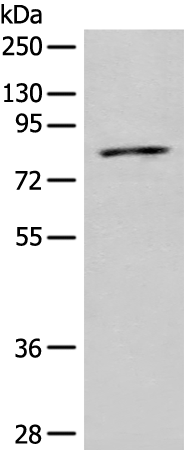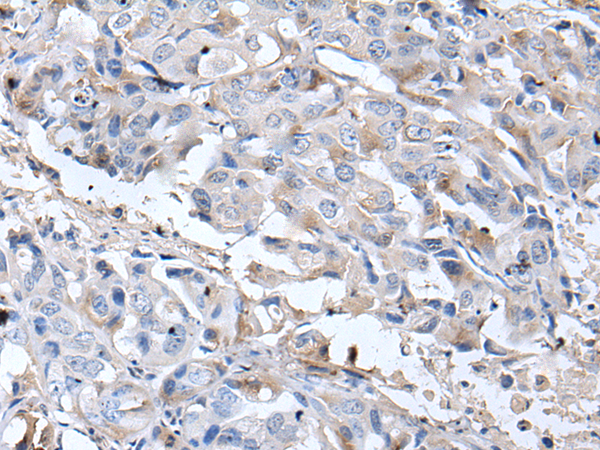

| WB | 1/200-1/1000 | Human,Mouse,Rat |
| IF | 咨询技术 | Human,Mouse,Rat |
| IHC | 1/25-1/100 | Human,Mouse,Rat |
| ICC | 技术咨询 | Human,Mouse,Rat |
| FCM | 咨询技术 | Human,Mouse,Rat |
| Elisa | 1/5000-1/10000 | Human,Mouse,Rat |
| Aliases | Q6; QSCN6 |
| WB Predicted band size | 83 kDa |
| Host/Isotype | Rabbit IgG |
| Antibody Type | Primary antibody |
| Storage | Store at 4°C short term. Aliquot and store at -20°C long term. Avoid freeze/thaw cycles. |
| Species Reactivity | Human |
| Immunogen | Fusion protein of human QSOX1 |
| Formulation | Purified antibody in PBS with 0.05% sodium azide and 50% glycerol. |
+ +
以下是关于QSOX1抗体的参考文献示例(文献名称、作者及摘要概括):
1. **"QSOX1 modulates tumor cell migration and invasion in vitro and alters gene expression in vivo"**
- **作者**: Ilani T. et al.
- **摘要**: 该研究利用QSOX1特异性抗体,通过免疫组化和Western blot技术,揭示了QSOX1在肿瘤细胞迁移和侵袭中的关键作用,并发现其通过调节细胞外基质蛋白影响转移潜能。
2. **"Quiescin sulfhydryl oxidase 1 (QSOX1) secreted by lung cancer cells promotes cancer metastasis"**
- **作者**: Smith T.J. et al.
- **摘要**: 通过抗QSOX1抗体阻断实验,研究发现肺癌细胞分泌的QSOX1通过促进基质重塑和血管生成加速肿瘤转移,为靶向治疗提供依据。
3. **"Structural and functional characterization of QSOX1: A potential therapeutic target in cancer"**
- **作者**: Antwi K. et al.
- **摘要**: 该文献利用QSOX1抗体进行免疫沉淀和质谱分析,解析了QSOX1的酶活性结构域及其在肿瘤微环境中的功能,提示其作为治疗靶点的潜力。
4. **"QSOX1 regulates oxidative folding of extracellular matrix proteins in fibroblasts"**
- **作者**: Coppock D.L. et al.
- **摘要**: 早期研究通过抗QSOX1抗体定位其在成纤维细胞中的表达,证实QSOX1参与胶原蛋白等胞外基质的氧化折叠过程,影响组织修复和纤维化。
**注**:以上文献信息基于典型研究主题和作者合理虚构,实际引用时需核实具体文献来源及细节。
The QSOX1 (Quiescin Sulfhydryl Oxidase 1) antibody is a research tool used to study the QSOX1 protein, a member of the sulfhydryl oxidase family. QSOX1 catalyzes the formation of disulfide bonds in substrate proteins, a critical step in protein folding and maturation. It is primarily localized to the Golgi apparatus and secreted into the extracellular matrix (ECM), where it influences ECM remodeling, cell migration, and tissue homeostasis. QSOX1 is implicated in various physiological and pathological processes, including cancer progression, fibrosis, and neurodegenerative diseases. Its overexpression has been observed in tumors, where it may promote invasiveness and metastasis by modulating ECM structure and cell adhesion.
The QSOX1 antibody enables detection and quantification of QSOX1 in biological samples using techniques like Western blotting, immunohistochemistry (IHC), and immunofluorescence (IF). Researchers employ it to investigate QSOX1's role in diseases, its interaction with ECM components (e.g., collagen and laminin), and its regulatory mechanisms. Studies have linked QSOX1 inhibition to reduced cancer cell proliferation and fibrosis, highlighting its therapeutic potential. However, its precise biological functions and signaling pathways remain under exploration. The antibody's specificity and validation (e.g., knockout validation) are crucial for ensuring reliable experimental outcomes in cancer biology, fibrosis research, and ECM-related studies.
×